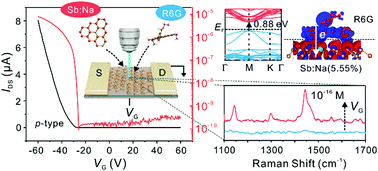Antimonene, which is similar to two-dimensional (2D) phosphorene, has recently gained considerable attention because of its thickness-dependent energy band structure. However, unlike phosphorene, undoped antimonene has an indirect bandgap only at the monolayer limit. In this work, an electrochemical sodium doping strategy was proposed to tune the energy band structure of antimonene. First-principles calculations indicated that a direct bandgap of 0.88 eV formed in 5.55% Na-doped antimonene, while undoped antimonene had an indirect bandgap of 2.38 eV. Optical and electrical measurements provided clear evidence for such a reconstruction of the energy band. We experimentally demonstrated p-type conduction in antimonene quantum dots (QDs)-based field-effect transistors. Furthermore, the induced direct bandgap enabled electric-field control of the surface-enhanced Raman scattering on plasmonic-free antimonene QDs. This allowed for detection of rhodamine 6G with a detection limit down to the sub-femtomolar level. Our study highlights the potential of doped antimonene as an emerging 2D semiconductor.

